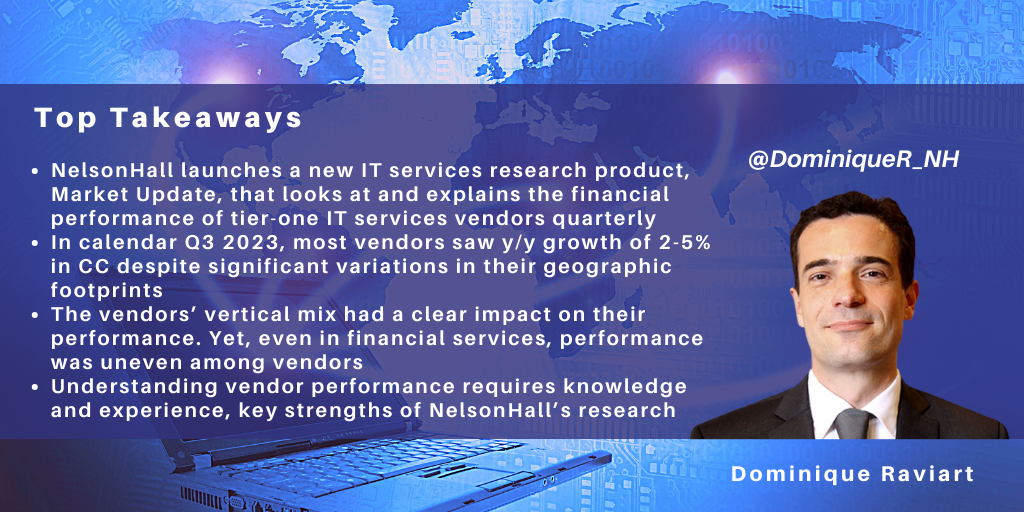posted on Nov 27, 2023 by Dominique Raviart

NelsonHall recently wrote a PoV on the current disconnect between GDP growth and IT services spending[1]. In October 2023, the IMF refreshed its GDP growth predictions; these include better 2023 GDP growth in the U.S. (+2.1%) and Japan (+20%) than the U.K. (+0.5%) and the Eurozone (+0.7%). Unusually, the IMF's predictions are not in line with our observations of IT services spending. In calendar Q1-Q3 2023, IT services spending growth fell sharply in the U.S. (to low single-digit), while the U.K. and Europe remained solid.
Performance Convergence in Q3 2023 Despite Different Footprints
In Q3 2023, NelsonHall launched a new IT services research product, Market Update[2], that looks at and explains the financial performance of tier-one IT service vendors in Q3 and compares their performance. There was a strong pattern of these vendors seeing decelerating constant currency (CC) revenue growth in the quarter.
Most vendors saw y/y growth of 2-5% in CC, and this, despite significant variations in their geographic footprints. For instance, TCS and Capgemini have different geographic mixes (TCS derives ~52% of its revenues from clients in North America; Capgemini: ~61% from clients in the U.K./Europe), yet they saw similar y/y revenue growth (TCS: +2.8% in CC, Capgemini: +2.3% in CC). Notably, although the U.S. continues to be soft, vendors with a dominant North American footprint did not underperform those (e.g., Capgemini and CGI) stronger in the U.K./Europe.
The vendor's vertical mix had a clear impact on their performance in the quarter. Vendors exposed to softness in the high-tech, financial services, retail & CPG, and North American telecom sector suffered more than their peers with a greater presence in the following sectors: government, U.S. healthcare, energy & utilities, and manufacturing. For instance, CGI was resilient in the U.S. in Q3 thanks to its government and healthcare footprint. However, a vendor's vertical mix is not the only factor explaining its topline performance in the quarter. There are other reasons: not all verticals are global.
Banking is an example of an industry impacted by the same factors globally (e.g., stock markets, inflation). In contrast, buying behaviors of IT services in sectors such as healthcare and telecoms tend to be more regional and have different dynamics. While healthcare is largely commercial in the U.S., it tends to be part of the public sector in the U.K./Europe.
Even in a global industry such as financial services, performance has been uneven: HCLTech's BFSI revenues were up 12.5% y/y in CC in Q3, while almost all its competitors experienced negative growth. Overall, vendors are still hit by mortgage slowdowns, and demand has also fallen in asset management, investment banking, cards, and payments. Some vendors will win out in the medium term from large vendor consolidation deals. Unsurprisingly, Insurance has been more resilient.
Big Deals Made the Difference
Several vendors have a track record in large deals, accepting competitive pricing for those in open tenders and the ability to raise their profitability. Other vendors emphasize they are being "selective" in their contract pursuits.
There is no silver bullet for understanding the various factors underlying the performance of different IT services vendors. It requires domain knowledge and experience combined with detailed knowledge of individual IT services providers' capabilities and financial performance: these are strengths of NelsonHall's research. Don't hesitate to contact Guy Saunders or Darrin Grove to connect with NelsonHall.
[1] See our IT Services – Market Update, for NelsonHall subscribers
[2] See the recent Quarterly Update, for NelsonHall subscribers.
